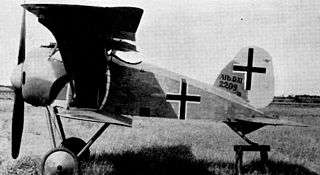Albatros D.XI
| Albatros D.XI | |
|---|---|
 | |
| Role | Fighter |
| Manufacturer | Albatros Flugzeugwerke |
| First flight | February 1918 |
| Retired | 1918 |
| Primary user | Germany |
| Number built | 2 |
|
| |
The Albatros D.XI was a German single-seat fighter biplane first flown in February 1918. It was the first Albatros fighter to use a rotary engine, in the form of the 120 kW (160 hp) Siemens-Halske Sh.III, and also featured a new wing construction with diagonal struts from the fuselage replacing traditional wire bracing.
Design & development
The wings had unequal spans with the upper planes having greater span than the lower ones, and were braced by I-struts with an aerofoil cross-section, additional rigidity being provided by twinned diagonal struts from the base of these to the top of the fuselage, located where the "landing wires" of a normal wire-braced biplane would be. The use of a rotary engine necessitated a large-diameter propeller and a correspondingly tall undercarriage.
The D.XI was armed with the same twin 7.92 mm (.312 in) Spandau LMG 08/15 machine guns employed on other Albatros fighters. Two prototypes were built, the first having balanced, parallel-chord ailerons and a four-blade propeller; and the second with inversely tapered, unbalanced ailerons and a two-blade propeller. The D.XI was not put into production.
Specifications (D.XI)
General characteristics
- Crew: one pilot
- Length: 5.58 m (18 ft 4 in)
- Wingspan: 8.00 m (26 ft 3 in)
- Wing area: 18.5 m2 (199 ft2)
- Empty weight: 494 kg (1,089 lb)
- Gross weight: 723 kg (1,594 lb)
- Powerplant: 1 × Siemens-Halske Sh.III, 120 kW (160 hp)
Performance
- Maximum speed: 190 km/h (120 mph)
- Endurance: 2 hours
Armament
- 2 × forward-firing 7.92 mm (.312 in) LMG 08/15 machine guns
References
| Wikimedia Commons has media related to Albatros D.XI. |
- Green, W.; Swanborough, G. (1994). The Complete Book of Fighters. London: Salamander Books. ISBN 1-85833-777-1.
- Das Virtuelle Luftfahrtmuseum